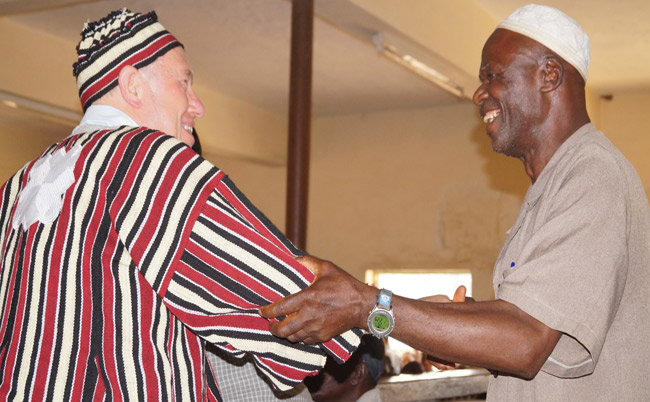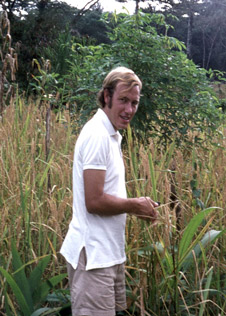Thursday 27 June 2019 12:17pm

Professor Tony Binns is made a chief in Kayima, Sierra Leone, in 2012.
Professor Tony Binns’ collaboration with Sierra Leone goes far beyond the research he began in 1974.
The University of Otago Ron Lister Professor of Geography spoke about his 45 years of collaborative links with Sierra Leone, West Africa, at the International Initiatives seminar series last week.

Professor Tony Binns picks rice in Sierra Leone in 1974.
When Professor Binns first touched down in Sierra Leone 45 years ago, he was a bright-eyed postgraduate student from the University of Birmingham.
“It was probably one of the best years of my life. It was absolutely instrumental in everything I’ve done since then.”
Professor Binns' doctoral research in 1974 was on the relationships between rural development and diamond mining in Sierra Leone, with focuses on the farming communities of Kayima and Panguma.
“What I was trying to do was to counter the government perception at the time that diamond mining was having a negative effect on rural development.”
Most diamonds in Sierra Leone are mined from alluvial deposits, meaning very little underground mining. In turn, the miners need to be fed, which the farming communities support, Professor Binns says.
He found mining was enriching the surrounding farming villages, with markets to sell products becoming commonplace.
“Diamonds have become a way of life for people in these communities.
“Diamond money is being invested back into the community. I argued that mining was actually having positive effects on the development of the communities.”
"It was probably one of the best years of my life. It was absolutely instrumental in everything I’ve done since then."
Since his first time in Sierra Leone, Professor Binns has travelled back there and also extensively throughout Africa.
His research assistant Professor Paul Tengbe has since become the head of the geography department at the University of Sierra Leone.
After his first trip to Sierra Leone Professor Binns taught at the University of Sussex for 30 years before moving across the world and starting at the University of Otago in 2004.
Sierra Leone has since faced Civil War (1991-2002) and the Ebola outbreak (2014-15), causing massive displacement, destruction of infrastructure and loss of life.
Through it all Professor Binns continues to maintain his connection with the country, and the villagers of Kayima have never forgotten him. In 2014, they made him a chief and in response he asked what they needed from him. They told him they needed an early childhood centre.
Students from the University of Otago raised $13,000 to build the centre. A further $7,500 was raised this year by students and St Margaret’s College residents which will go towards upgrading the village’s health clinic, which serves more than 100,000 people in the region.
Professor Binns’ original research in Sierra Leone is now being followed up by his PhD research student Jerram Bateman, who is researching community-based rural development in post-conflict Sierra Leone.
“The country is still desperately poor, and having had 11 years of civil war and two years of Ebola it’s going to take time [to recover]. They do have a stable government though and fortunately there is no Islamist extremism,” Professor Binns says.
He plans to return to Sierra Leone in January.
